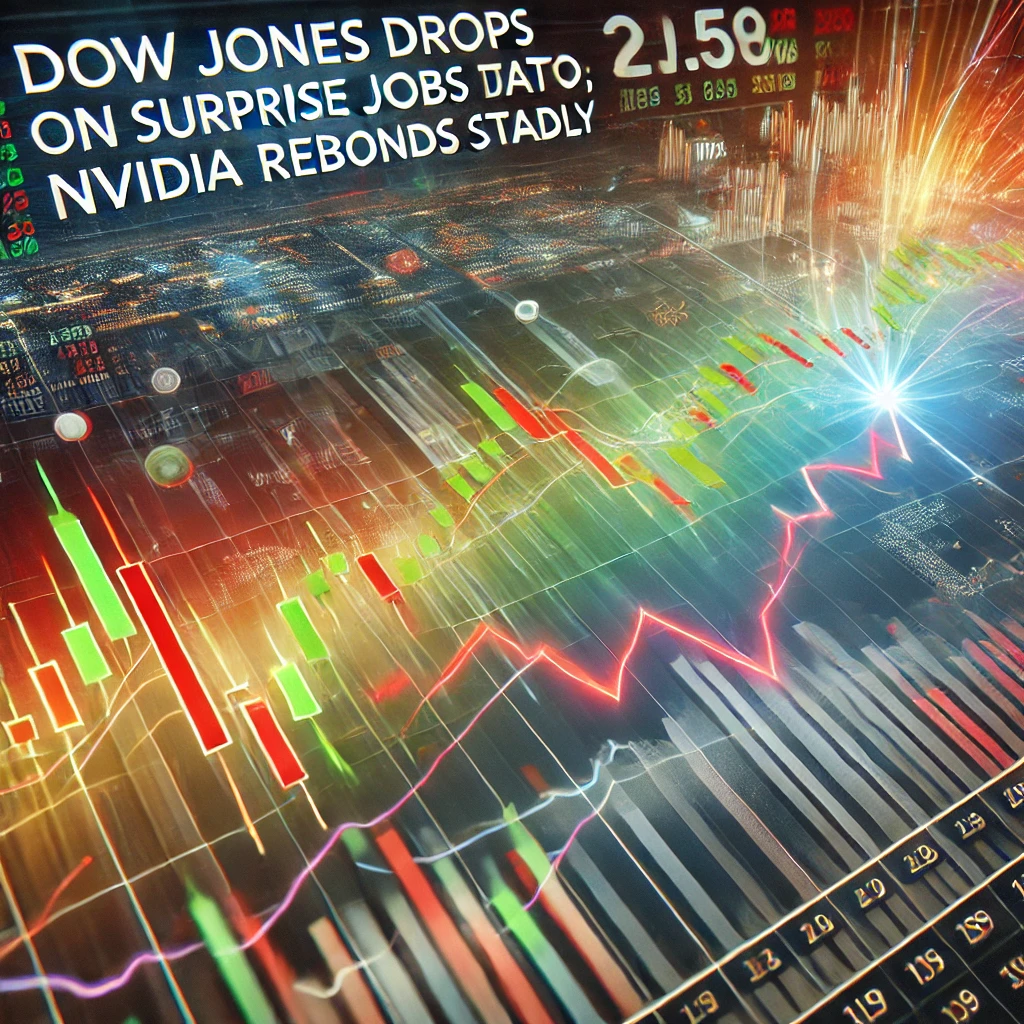
The first week of January 2025 saw significant volatility in U.S. financial markets. The Dow Jones Industrial Average faced a downturn following the release of stronger-than-expected jobs data, which raised concerns about the Federal Reserve’s potential monetary policy adjustments. Nvidia, on the other hand, showed resilience by rebounding from a critical support level after initially suffering a steep decline. These developments have set the stage for a closely watched week in financial markets.
Impact of the Surprise Jobs Data
The economic data released for November and December 2024 revealed unexpected strength in the labor market. November’s job openings surged to 10.5 million, far surpassing analyst expectations, and December’s services sector activity grew at its fastest pace in several months. This data underscored the U.S. economy’s resilience despite earlier concerns about a potential slowdown.
While such economic strength is generally seen as a positive, it triggered anxiety in the markets. A stronger labor market often leads to increased consumer spending, which can fuel inflation. The Federal Reserve, which had been signaling a potential easing of interest rates in 2025, may now find itself reconsidering its stance to address these inflationary pressures.
The implications of this surprise data were felt immediately in the bond markets. The yield on the 10-year Treasury note rose to 4.68%, its highest level since May 2024. Higher yields often signify rising borrowing costs, which can suppress economic activity and corporate profits.
Investors, who had been optimistic about rate cuts, were forced to reassess their expectations. This recalibration led to broad market volatility, with equities bearing the brunt of the uncertainty. The ripple effects of this data extended across sectors, emphasizing the interconnectedness of economic indicators and market performance.
Despite the market’s negative reaction, some analysts argued that the robust labor market data was a sign of economic health. However, the fine balance between growth and inflation remains a delicate issue for policymakers and investors alike.
Dow Jones Performance Amid Uncertainty
The Dow Jones Industrial Average declined by 0.4% on January 7, 2025, closing at 42,528.36. This marked a significant shift from the index’s relatively stable performance in late 2024. The decline was attributed to heightened investor concerns over the Federal Reserve’s response to the surprising economic data.
The Dow’s composition, which includes industrial giants and blue-chip companies, makes it a key indicator of overall market sentiment. The drop reflected a cautious approach by investors, who began repositioning their portfolios to account for potential rate changes.
Industrial and consumer staples sectors within the Dow saw notable declines. These industries, which are sensitive to borrowing costs and consumer demand, faced headwinds from rising Treasury yields and inflation fears. Financials, too, were impacted as higher rates could squeeze margins for banks in the near term.
Interestingly, some components of the Dow managed to hold their ground, underscoring the index’s diverse makeup. Defensive stocks in healthcare and utilities saw modest gains, as investors sought safe havens during the market’s turbulent week.
Analysts noted that while the Dow’s decline was concerning, it also presented opportunities for long-term investors. The pullback in valuations could offer attractive entry points for those with a longer investment horizon.
Broader Market Trends
The repercussions of the surprise jobs data were felt across major U.S. indices. The S&P 500, which tracks a broader range of industries, dropped 1.1% to 5,909.03. The Nasdaq Composite, heavily weighted toward technology, experienced a sharper decline of 1.9%, closing at 19,489.68.
High-growth stocks, particularly in the technology sector, were among the hardest hit. These companies, which rely on strong future earnings to justify their valuations, are especially vulnerable to rising interest rates. With the 10-year Treasury yield climbing, the present value of these future earnings declined, prompting sell-offs in the sector.
Small-cap stocks also struggled, as smaller companies are generally more sensitive to changes in borrowing costs. The Russell 2000 index, which tracks small-cap stocks, posted a significant decline, reflecting the broader uncertainty in equity markets.
Despite the declines, some sectors showed relative resilience. Energy stocks benefitted from stable oil prices, while defensive sectors like healthcare and utilities provided a buffer against the market’s overall downturn.
Nvidia’s Eventful Week
Nvidia, one of the most prominent names in the semiconductor and AI industries, had a volatile week. On January 7, the company’s stock plummeted by 6.2%, wiping out nearly $200 billion in market value. This decline was part of a broader sell-off in the technology sector but was also influenced by Nvidia-specific factors.
The drop occurred despite Nvidia’s strong presence at CES 2025, where CEO Jensen Huang unveiled new gaming graphics cards and highlighted advancements in AI technology. While these innovations received positive attention, they were overshadowed by macroeconomic concerns and the broader market sentiment.
However, Nvidia demonstrated resilience by rebounding modestly in premarket trading on January 8, with its stock rising 0.3% to $141.95. This recovery was attributed to strong support at critical technical levels, as well as confidence in the company’s long-term growth prospects.
Nvidia’s performance underscored the challenges faced by high-growth companies in the current environment. While its fundamentals remain strong, external factors such as interest rates and market sentiment continue to exert significant influence.
Investors are closely watching Nvidia’s next moves, particularly as the company expands its presence in AI and gaming. These sectors offer significant growth opportunities, but they also come with heightened competition and regulatory scrutiny.
Federal Reserve Minutes and Investor Outlook
One of the key events investors are awaiting is the release of the Federal Reserve’s December 2024 meeting minutes. These minutes will provide valuable insights into policymakers’ views on inflation, interest rates, and economic growth.
The timing of this release is critical, as it comes on the heels of the surprise jobs data. Investors are eager to understand whether the Federal Reserve anticipated such strong economic performance and how it plans to address the associated risks.
Market participants expect the minutes to clarify the central bank’s policy direction. Will the Fed maintain its current stance, or will it signal a shift toward a more hawkish approach? The answers to these questions will likely shape market sentiment in the weeks ahead.
The minutes are also expected to highlight discussions about the global economy, given the interconnected nature of financial markets. Any mention of geopolitical risks or international trade dynamics could further influence investor behavior.
What’s Next for Markets?
As the week progresses, additional data releases, including non-farm payrolls, are expected to provide further insights into the health of the U.S. economy. These updates will play a crucial role in shaping investor expectations and market dynamics.
In the technology sector, Nvidia’s performance will remain a focal point. The company’s ability to sustain its recovery and navigate macroeconomic challenges will be closely watched by analysts and investors alike.
Broader market trends will depend heavily on the Federal Reserve’s actions and communications. Clear guidance from the central bank could help stabilize markets, while uncertainty may prolong the current volatility.
For investors, the current environment underscores the importance of diversification and risk management. Balancing short-term challenges with long-term opportunities will be essential as markets adapt to new economic realities.
Feel free to check out our other website at : https://synergypublish.com

